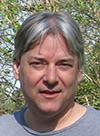 Frank Chlebana
Frank Chlebana
E-mail: chlebana@fnal.gov
Biography
I obtained my BASc at the University of Waterloo, where I was enrolled in the co-op program and spent my work terms at Nortel developing lithography procedures. I obtained my MSc and PhD at the University of Toronto. As a graduate student I worked on the assembly procedures for the ZEUS depleted uranium calorimeter and developed the hardware/software to measure the stack height as the calorimeter was assembled to ensure uniform stacking. I moved to DESY where I developed the readout framework for the Third Level Trigger consisting of a farm of Silicon Graphics computers with a custom VME interface board. My thesis was titled “First measurement of the proton structure function F2 with the ZEUS detector”. I then had a postdoc at NIKHEF while remaining stationed at DESY and was responsible for maintaining the Second Level Trigger, consisting of an array of transputers programmed in OCCAM. During that time I continued working on structure function measurements and explored different methods for the kinematic reconstruction.
I then moved to Fermilab as an RA working on the “Double differential inclusive jet cross section” which was used to differentiate between structure function parameterizations. I also worked on development and studies of different jet reconstruction algorithms. I initially worked on defining the online data format then developed the DAQ and a graphical user interface for the CDF Run Control. I served as convener of the QCD group and eventually was selected to lead the DAQ group at CDF.
When I first joined CMS I initially worked on jet reconstruction algorithms and then served as a convenor for the HCAL Detector Performance Group (DPG). This was a particularly exciting period which spanned the time from before taking data through stable running. I was the Fermilab Calorimeter group leader and served as the deputy L2 HCAL manager for the US-CMS phase 1 upgrade. I led the HCAL software task force to update the HCAL readout and support software to accommodate the HCAL hardware upgrades. I also led the HE scintilator radiation task force which developed a rate dependent radiation damage model and simulation used to project damage from radiation and aging effects, concluding that the HE scintillator would not have to be replaced. I later moved to the HGCal group and served as convener of the HGCal DPG with a focus on developing the simulation and reconstruction used to demonstrate the HGCal performance for the HGCal TDR. I then moved to the MIP Timing Detector (MTD) group and currently serve as the Deputy L2 MTD manager for the US-CMS phase 2 upgrade project. I have also served on the US-CMS elections committee and as the US-CMS HGCal IB chair. I have served on the Fermilab Thesis Award committee and am currently on the LPC G&V selection committee. I served as a member of the User’s Executive Committee where I was the chair of the Quality of Life sub-committee and have participated twice in the yearly Washington lobbying visit. I served on the Fermilab PPD Climate Implementation group tasked with implementing the recommendations from a recent employee survey. I served as chair of the Fermilab RA mentoring committee. I currently and serving as the co-chair of the Fermilab Scientist Advisory Committee, the deputy Fermilab CMS Department head.
